The GeForce GTX 660 Ti Review, Feat. EVGA, Zotac, and Gigabyte
by Ryan Smith on August 16, 2012 9:00 AM ESTOC: Power, Temperature, & Noise
Our final task is our look at the overclocking capabilities of our GTX 660 Ti cards. Based on what we’ve seen thus far with GTX 660 Ti, these factory overclocked parts are undoubtedly eating into overclocking headroom, so we’ll have to see just what we can get out of them. The very similar GTX 670 topped out at around 1260MHz for the max boost clock, and between 6.6GHz and 6.9GHz for the memory clock.
| GeForce 660 Ti Overclocking | |||||
| EVGA GTX 660 Ti SC | Zotac GTX 660 Ti AMP | Gigabyte GTX 660 Ti OC | |||
| Shipping Core Clock | 980MHz | 1033MHz | 1033MHz | ||
| Shipping Max Boost Clock | 1150MHz | 1175MHz | 1228MHz | ||
| Shipping Memory Clock | 6GHz | 6.6GHz | 6GHz | ||
| Shipping Max Boost Voltage | 1.175v | 1.175v | 1.175v | ||
| Overclock Core Clock | 1030MHz | 1033MHz | 1083MHz | ||
| Overclock Max Boost Clock | 1200MHz | 1175MHz | 1278MHz | ||
| Overclock Memory Clock | 6.5GHz | 6.8GHz | 6.6GHz | ||
| Overclock Max Boost Voltage | 1.175v | 1.175v | 1.175v | ||
As we suspected, starting with factory overclocked cards isn’t helping here. Our Zotac card wouldn’t accept any kind of meaningful GPU core overclock, so it shipped practically as fast as it could go. We were able to squeeze out another 200MHz on the memory clock though.
Meanwhile our EVGA and Gigabyte cards fared slightly better. We could push another 50MHz out of their GPU clocks, bringing us to a max boost clock of 1200MHz on the EVGA card and 1278MHz on the Gigabyte card. Memory overclocking was similarly consistent; we were able to hit 6.5GHz on the EVGA card and 6.6GHz on the Gigabyte card.
Altogether these are sub-5% GPU overclocks, and at best 10% memory overclocks, which all things considered are fairly low overclocks. The good news is that reference-clocked cards should fare better since their headroom has not already been consumed by factory overclocking, but binning also means the best cards are going to be going out as factory overclocked models.
Moving on to our performance charts, we’re going to once again start with power, temperature, and noise, before moving on to gaming performance.

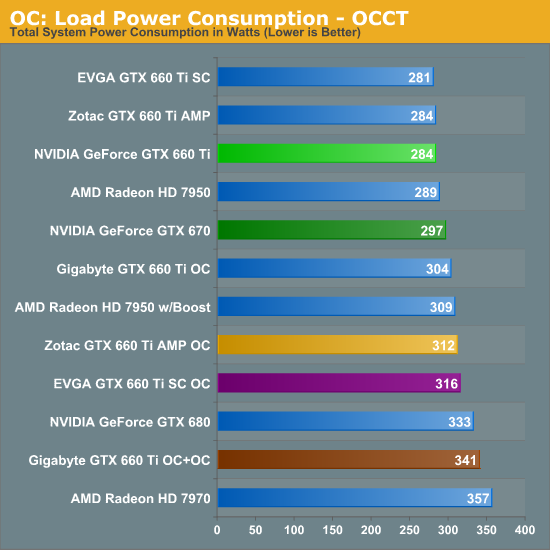
Unsurprisingly, given the small power target difference between the GTX 670 and the GTX 660 Ti, any kind of overclocking that involves raising the power target quickly pushes power consumption past the GTX 670’s power consumption. How much depends on the test and the card, with the higher power target Gigabyte card starting with a particular disadvantage here as its power consumption ends up rivaling that of the GTX 680.
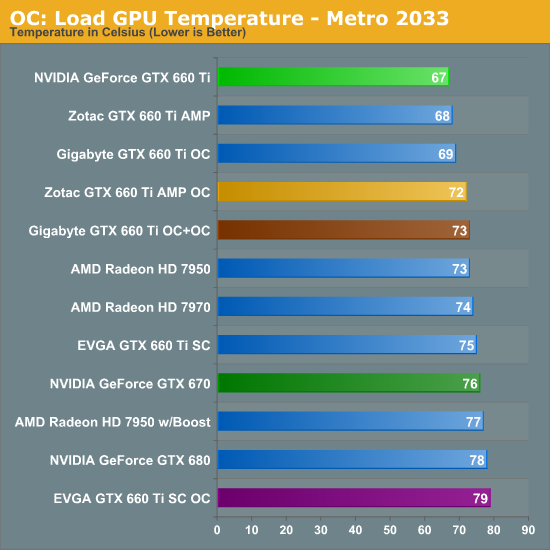
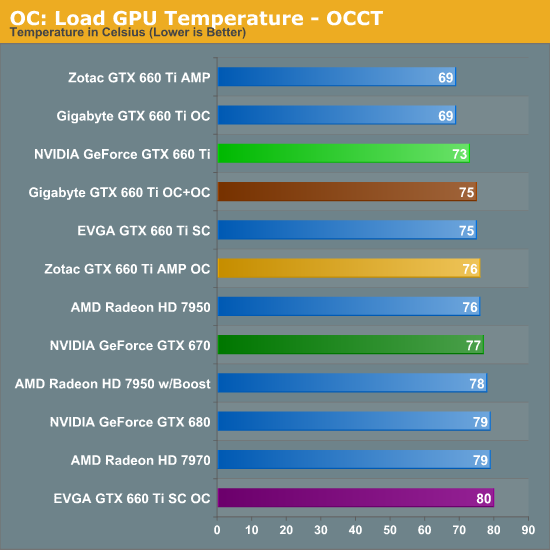
We also see the usual increase in load temperatures due to the increased power consumption. The Zotac and Gigabyte cards fare well enough due to their open air coolers, but the blower-type EVGA card is about as high as we want to go at 80C under OCCT.
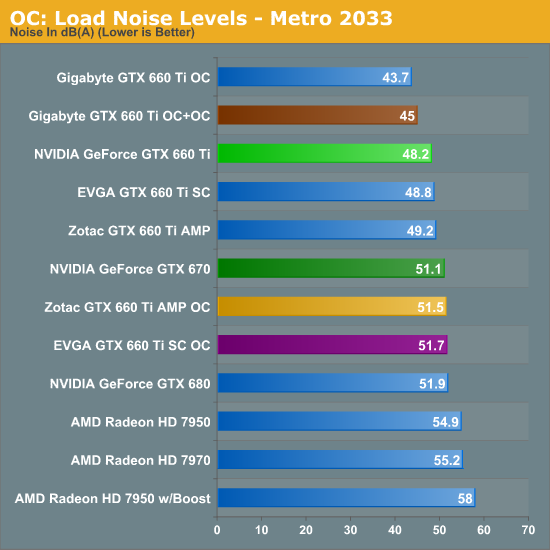
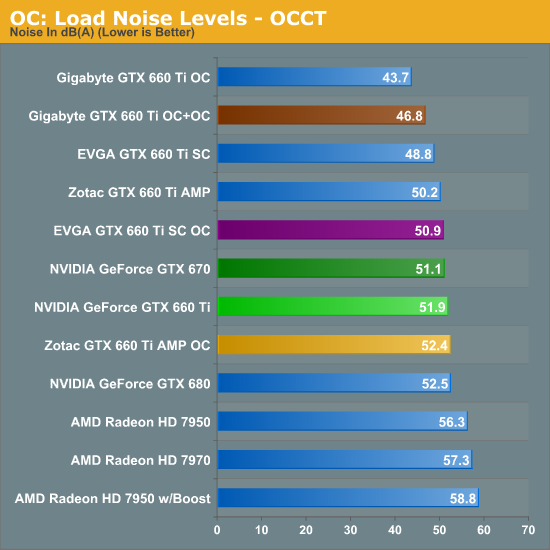
Last but not least, looking at noise levels we can see an increase similar to the temperature increases we just saw. For the Zotac and EVGA cards noise levels are roughly equal with the reference GTX 680, which will be important to remember for when we’re looking at performance. Meanwhile the Gigabyte card continues to shine in these tests thanks to its oversized cooler; even OCCT can only push it to 46.8dB.










313 Comments
View All Comments
wintermute000 - Thursday, August 16, 2012 - link
@ 720p the lower range of cards (ATI 78XX etc.) will destroy framerates even with everything turned up, there is no need to waste time benching!!!!!!!!!!!zlandar - Thursday, August 16, 2012 - link
Anyone notice how the 7950 went from 69 fps at 2560 x 1600 on the 5/10/12 review to 85 fps on today's review? That simply from improved driver performance?Ryan Smith - Thursday, August 16, 2012 - link
Correct. Beginning with Catalyst 12.7 AMD's Skyrim performance has significantly improved.thegr8anand - Thursday, August 16, 2012 - link
Just wondering, Toms say the performance of 660 is 3-4% below 7870 while Anand says its 10-15% more. What gives??Ananke - Thursday, August 16, 2012 - link
This is a castrated effectively 128-bit 24 ROPs hugely overpriced card. Best Buy had it for several days already, it is in the same green box as 560ti, and apparently nobody paid attention it was taken to the sale floor :). So, some people :):) already bought it, tried it, and can confirm it is not worth the money asked. In my sole opinion it can justify max. $199 at launch. It is disappointing. So, for whoever has and feels OK, GTX 670 for $400 is the way to go, otherwise pick up Radeon 7950 or 7870. I personally will choose the AMDs because of compute, NVidia current generation computing just plain sucks, but if you only play one game BF3 :):):) then maybe several hundred dollars is OK to spend on the GTXs.silverblue - Friday, August 17, 2012 - link
It's a 192-bit memory bus, not 128-bit.Different reviews have different setups. Toms seems to be the exception as regards the 7870 being superior; in general, the 660 Ti comes closer to the 7950. In some titles, it's shockingly fast.
If there was to be a standard 660, all NVIDIA could do here is to cut down the number of shaders and texture units - clocks won't do it as you'll just clock them back up again, and memory is already nerfed.
TheJian - Monday, August 20, 2012 - link
"Closer to the 7950"?? Careful, sounds like ignoring the evidence. BEATS it, and usually the 7970 (even ghz at times) too...see all my other posts...Pointless to even respond here?.. I've already written every game at hardocp, anand show victories for Skyrim, Batman AC, Witcher2, Battlefield3, Battlefield 3 Multiplayer, Portal 2, max payne 3...That rules out HardOCP I guess. Anand added a few more, Shogun 2 (another landslide for 660 TI, even against 7970), Dirt3 used here anand - Wash (though minimums do show Nvidia as Ryan points out)...
Civ5, landslide again at 1920x1200 here anandtech...Metro2033 here anandtech, <5% win for Nvidia %1920x1200 (I call it a wash I guess)...
So which game can I point to that will be OK to you? I'll try to help you let AMD win...:)
Understand Tomshardware, turned all cards to default...So you buy a card and downclock them all to test...ROFL "we dropped each card's clock rates to reference levels." from page 2 of their article:
http://www.tomshardware.com/reviews/geforce-gtx-66...
That same page 2 from their review at the bottom of the graphics card list:
"All overclocked cards reduced to reference specification for testing"
So, every card will perform UNLIKE what you would buy on either side. Their review is worthless as they are nerfing even ATI cards. Though it hurts NV more. I'm not sure why they even ran the benchmarks...They should have just said look elsewhere for real answers to how these will perform when you buy them out of the box. Nobody else did this, which is why they are ODD in their results.
CeriseCogburn - Thursday, August 23, 2012 - link
That's great them Tom's Hardware can put 100% or near so amd cards in their bang for buck monthly again perpetuating the big lie, jiggering the price categories up or down depending on what makes amd fanboys gleeful. It's so ridiculous they get best card for 115, best card for 155, then next month, best card for 90, best card for 135 ETC, and then they squish the crap amd card in just uner the number, and their attached price link shows it 50 bucks higher on the day of their postYou thought this place was bad ? LOL
Then the rabid amd fans at toms put a minus 20 on every comment that doesn't kiss the amd quite often. They're goners.
They do have more than 1 reviewer, so some times you'll get something sane, but not very often. It's been degrading for a long time, it's really sad.
CeriseCogburn - Sunday, August 19, 2012 - link
nVidia's profits and sales show very few people are amd fanboyyed out like you are.I recommend not believing nor following a word of advice from you.
claysm - Friday, August 17, 2012 - link
It has a lot to do with what settings are being used in-game. The Tom's article admits at the end that their setup could be AMD favored, since they tend to prefer high levels of AF and AA, which eat up memory bandwidth and heavily tax the memory subsystem (a strong point for AMD).